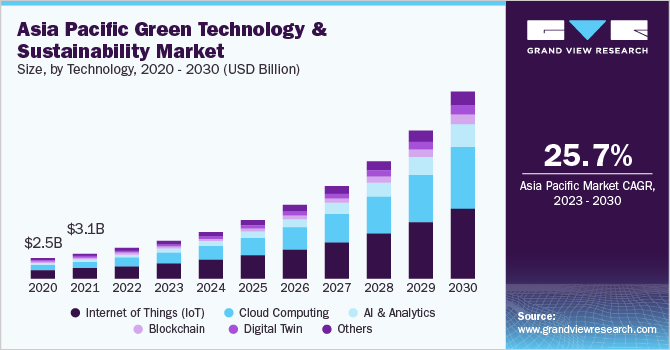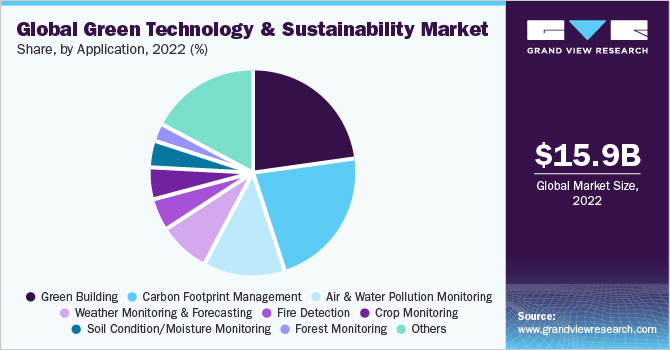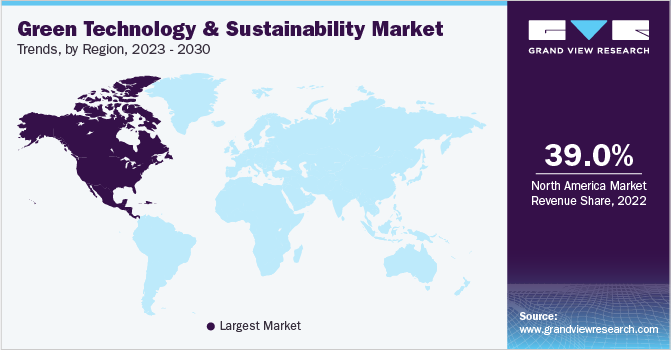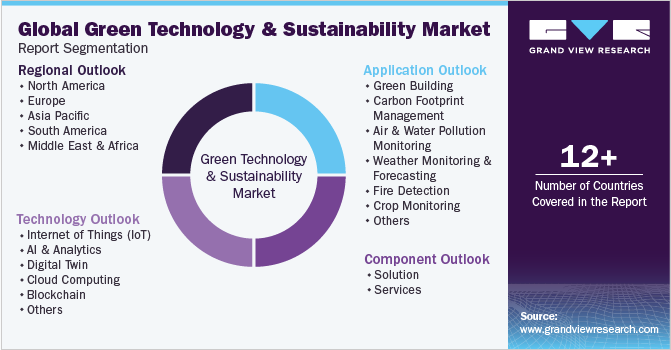- Home
- »
- Next Generation Technologies
- »
-
Green Technology & Sustainability Market Size Report, 2030GVR Report cover
![Green Technology & Sustainability Market Size, Share & Trends Report]()
Green Technology & Sustainability Market Size, Share & Trends Analysis Report By Component (Solution, Services), By Technology, By Application, By Region, And Segment Forecasts, 2024 - 2030
- Report ID: GVR-4-68039-945-7
- Number of Report Pages: 100
- Format: PDF, Horizon Databook
- Historical Range: 2018 - 2022
- Forecast Period: 2024 - 2030
- Industry: Technology
Report Overview
The global green technology & sustainability market size was valued at USD 19.07 billion in 2023 and is projected to grow at a compound annual growth rate (CAGR) of 22.9% from 2024 to 2030. The industry is expected to increase as environmental awareness and concerns about global warming rise among organizations and individuals. Integrating advanced technologies such as the Internet of Things (IoT), artificial intelligence, and blockchain increasingly focuses on reducing energy wastage, forecasting environmental changes, and enhancing green technologies' efficiency and effectiveness. The adoption of carbon pricing methods and trading systems is anticipated to encourage companies to lower carbon emissions with the help of digital technologies. Favorable government policies and incentives to reduce carbon emissions and promote clean energy are expected to drive the demand for green technologies and sustainable solutions.

One of the primary growth drivers for this market is the increasing global awareness about the impacts of climate change and the alarming need to reduce carbon emissions. Governments, corporations, and individuals embrace sustainable practices to minimize the environmental impact of businesses, processes, and consumption patterns. Countries such as China, Germany, and the U.S. have invested significantly in initiating a shift towards renewable energy sources, solar farms, and wind turbines, making renewables more cost-effective than traditional fossil fuels. Increasing innovation and rising availability of cost-efficient renewable energy solutions have also driven the growth of this market.
In addition, government initiatives to promote the use of green technology and increase awareness regarding sustainability are also expected to contribute to the growth of this market during the forecast period. Multiple governments provide subsidiaries to consumers who shift from conventional energy solutions to renewable sources. Furthermore, the various nations' inclusion of green technology and sustainability in welfare activities and schemes has backed growing demand for this market. For instance, in March 2024, the U.S. government administration introduced a pilot project for Clean Energy Connector through the collaboration of the Department of Health and Human Services (HHS) and the Department of Energy (DOE). Clean Energy Connector is a tool designed to connect families eligible under the Low-Income Home Energy Assistance Program (LIHEAP) with community solar subscriptions.
Use of advanced technology tools to reduce carbon footprint through multiple ways, such as performance enhancements in the logistics industry, use of robotics in shipping and warehousing, adoption of drones and robots in manufacturing, delivery, inventory management, and integration of technologies such as artificial intelligence (AI) and Internet of Things (IoT) with business operations has resulted in noteworthy changes. The use of wireless technologies to enhance real-time monitoring of hardware and devices and reduce on-site technician visits in the manufacturing industry has reduced the carbon emissions of multiple users. Shifting to smart building structures to improve energy efficiency and adopting modern technology-driven systems for remote monitoring of asset health or resolving machine failures have also contributed to the growth of this market.
Component Insights
The solution segment dominated the market and held the largest revenue of 67.8% in 2023. Emerging technologies provide new opportunities for green technology and sustainable development, considering social, economic, and environmental factors. As a result, increasing awareness of technology's detrimental influence on the environment is a primary driver of Green Technology & Sustainability solutions adoption across verticals worldwide, propelling the Green Technology & Sustainability market forward. For instance, in February 2024, SYMETRI, a part of Addnode Group, one of the prominent companies in the engineering and design technology industry, launched Navigate Zero, a specially developed solution for achieving sustainability and energy efficiency for manufacturing organizations and the Architecture, Engineering, Construction, and Operation (AECO). Increasing awareness regarding climate change, growing adoption of sustainability strategies, and rising inclination towards accomplishing reduced carbon emissions in multiple industries are expected to drive growth for this segment in the approaching years.
The service segment is anticipated to witness the fastest CAGR during the forecast period. As organizations increasingly prioritize sustainability, they require specialized consulting, implementation, and maintenance services to navigate the complex landscape of environmental regulations and technologies. Furthermore, the growing trend of corporate sustainability initiatives is driving the need for services that support the measurement, reporting, and reduction of carbon footprints. Moreover, the increasing adoption of IoT, AI, and cloud computing in sustainability applications is fueling the growth of the services segment, as organizations require assistance effectively leveraging these technologies.
Technology Insights
The IoT segment held the largest revenue share of the global green technology and sustainability market in 2023. The growth of this segment is attributed to its capabilities to connect devices and systems, facilitating real-time data collection and analysis essential for driving sustainability initiatives across various sectors. IoT applications enable efficient energy management, waste reduction, and environmental monitoring, making them invaluable for organizations aiming to minimize their ecological footprint. Furthermore, integrating IoT with other technologies, including AI and Cloud computing, further boosts its impact, allowing for predictive analytics and scalable solutions that promote sustainable practices. For example, Schneider's electric green building "The Edge" uses IoT connectivity to increase energy comfort and efficiency.
The cloud-computing segment is expected to witness the fastest CAGR over the forecast period. Cloud computing enables businesses to share resources, which maximizes utilization and minimizes energy consumption compared to traditional on-premises data centers. Cloud computing provides many sustainability advantages through enhancing energy efficiency, decreasing hardware requirements, and lessening environmental impact. It allows businesses to maximize resource utilization, reducing energy and greenhouse gas emissions. Cloud computing assists organizations in reducing emissions in numerous ways, including reduced paper waste, reduced use of hardware, lessened energy consumption, and more.
Application Insights
The green building segment dominated the market in 2023. Green building, also known as sustainable building, is designing and implementing processes and structures that are environmentally resource-efficient and responsible throughout the life cycle, from site selection to design, maintenance, construction, operation, renovation, and deconstruction. It incorporates characteristics of economy, durability, usability, and comfort into the traditional building design. Moreover, stringent government regulations and incentives to promote energy-efficiency and encourage both developed and developing countries to adopt green building practices have also contributed to the growth of this segment. For instance, initiatives such as LEED (Leadership in Energy and Environmental Design) certification have become benchmarks for sustainable construction, driving demand for eco-friendly materials and technologies.

The carbon footprint management segment is expected to witness the highest CAGR during the forecast period. Growth of this segment is primarily driven by the growth of increasing regulatory pressures, technological advancements, and rising consumer awareness. Governments worldwide are implementing stricter regulations and policies to reduce greenhouse gas emissions. This has created a strong demand for carbon footprint management solutions to help governments and organizations track and manage their emissions to comply with these regulations.
Regional Insights
North America dominated the green technology & sustainability market with a revenue share of 38.7% in 2023. The growth of this market is attributed to the rising number of investments and initiatives in the green environment. For instance, in October 2023, the U.S. Department of Energy (DOE), under the leadership of the Biden-Harris Administration, announced an investment of USD 30 million to accelerate the sustainability of federal buildings and innovation in clean energy technology. Increasing investments in research and development, followed by innovation and new product launches, are expected to generate greater growth for this market in the approaching years.

U.S. Green Technology & Sustainability Market Trends
The U.S. held the largest revenue share of the North America green technology & sustainability market in 2023. The growth of this market is attributed to its robust government support and technological innovation. The increasing consumer awareness and demand for eco-friendly solutions further fuel the region's growth. The U.S. is home to several leading technology companies, such as Apple, Microsoft, and Google, leveraging their technologies in sustainable practices and green technology. For instance, in April 2024, ENGIE Impact collaborated with Kraft Heinz to develop decarbonization roadmaps that have enabled the organization to secure up to USD 170 million from the U.S. Department of Energy. The partnership aims to significantly reduce emissions at ten Kraft Heinz plants across the U.S. by over 99% from 2022 levels, contributing to the company's goal of achieving net-zero carbon emissions by 2050.
Europe Green Technology & Sustainability Market Trends
Europe Green Technology & Sustainability market held a significant share in 2023. The region's Green Technology & Sustainability market growth is driven by increasing investments in renewable energy, stringent environmental regulations, and growing demand for sustainable products. The growth of this region is mainly driven by markets such as the UK, Germany, France, and others, which have made substantial investments in renewable energy and are committed to sustainability, encouraging industries to adopt green technologies. The growth of smart city initiatives and technological advancements such as IoT and AI further enhance the region's capabilities in managing energy consumption and waste. Furthermore, the European Green Deal, a set of policies that aims to reduce carbon emissions and achieve carbon neutrality by 2050, is expected to fuel growth in this industry during the forecast period.
The UK green technology & sustainability market dominated the regional industry in 2023. Increasing public awareness regarding climate concerns and rising investments in renewable energy are the primary factors driving this market's growth. Increasing investments in renewable energy, energy efficiency, and sustainable infrastructure have also recently generated many opportunities for this industry. For example, in July 2024, the UK government announced a budget of approximately USD 1.60 billion to support domestic clean energy initiatives and enhance the UK's energy stability. In addition, the growing demand for sustainable products and services from UK consumers is fueling market growth as companies seek to reduce their environmental footprint and gain competitive advantage.
Asia Pacific Green Technology & Sustainability Market Trends
The Asia Pacific green technology & sustainability market is anticipated to experience the fastest CAGR over the forecast period. Rapid industrialization, urbanization, increasing awareness regarding the significance of adopting sustainability practices, and growing government support are expected to fuel the growth of this regional industry in the coming years. The presence of countries such as China and India, which contribute large amounts to global greenhouse gas emissions, is expected to increase demand for this market in the region. Several governments and organizations in this region are implementing supportive policies for renewable energy development to reduce carbon footprints. For instance, in September 2023, Hewlett Packard Enterprise (HPE) and Schneider Electric expanded the long-standing partnership between two prominent organizations to provide a comprehensive suite of sustainable IT solutions and services to customers across Asia Pacific. The collaboration aims to help enterprises in the region accelerate their progress towards sustainability goals and reduce their environmental impact.
India held a substantial market share in the green technology & sustainability market in 2023. The growth factors driving the region are increasing industrialization, a rapidly growing economy, and demand for renewable solutions. The region is the third-largest energy consumer in the world and is experiencing significant growth in the renewable energy sector, which is driving the region's growth. The Ministry of New and Renewable Energy has set targets to achieve 500 GW of electricity generation through non-fossil-based sources by 2030. Growing economy and urbanization have created a huge demand for sustainable infrastructure, including green buildings, smart cities, and electric vehicles. They are, furthermore, increasing investments and collaboration fuel growth in India's green technology & sustainability market.
Key Companies & Market Share Insights
Some of the key companies operating in the green technology and sustainability market are ENGIE IMPACT, General Electric Company, Schneider Electric, Wolters Kluwer N.V. and others. Organizations are focusing on increasing their customer base to gain a competitive edge in the industry. Therefore, key players are taking several strategic initiatives, such as mergers and acquisitions and partnerships with other major companies.
-
ENGIE IMPACT is a division of the ENGIE Group that partners with companies to accelerate their decarbonization efforts worldwide. The company produces power using various sources such as natural gas, coal, nuclear, hydro, wind, biomass, geothermal, and solar. ENGIE IMPACT delivers, exchanges, and markets natural gas and a wide range of services related to energy efficiency.
-
General Electric Company, one of the prominent organizations in the technology and innovation industry, offers sustainable energy solutions through GE Vernova that includes gas power, stream power, hydropower, nuclear power, offshore wind, wind turbine blades, electrification solutions, power conversion, solar & storage solutions, advanced research, consulting services, and others.
Key Green Technology & Sustainability Companies:
The following are the leading companies in the green technology & sustainability market. These companies collectively hold the largest market share and dictate industry trends.
- Cority
- CropX inc.
- ENGIE Impact
- General Electric Company
- Lo3 Energy
- Microsoft
- Salesforce, Inc.
- Schneider Electric
- Xylem
- Wolters Kluwer N.V.
Recent Developments
-
In August 2024, North Battleford in Saskatchewan modernized its utility operations by implementing advanced technology from Xylem to tackle aging water infrastructure and reduce water loss. This initiative involves the adoption of intelligent water meters and the Sensus FlexNet communication network, which allows for real-time monitoring and proactive leak detection.
-
In August 2024, CropX and CNH Industrial announced strategic API integration for sustainable precision farming. The API connection enables seamless data transfer from CNH machinery to the CropX platform for visualization, record-keeping, planning, and variable-rate applications, allowing farmers to access a wide range of data from various farming activities.
-
In July 2024, Xylem, a major market participant in the water technology and innovation industry, announced its investing strategy goals to support emerging companies and water service providers tackling critical climate challenges related to water scarcity, quality, and decarbonization through direct investments. The company intends to enhance the availability of water solutions to tackle critical through direct investments in startups that focus on innovation in water technologies.
Green Technology & Sustainability Market Report Scope
Report Attribute
Details
Market size value in 2024
USD 23.10 billion
Revenue Forecast in 2030
USD 79.65 billion
Growth Rate
CAGR of 22.9% from 2024 to 2030
Base year for estimation
2023
Historical data
2018 - 2022
Forecast period
2024 - 2030
Quantitative units
Revenue in USD million and CAGR from 2024 to 2030
Report Coverage
Revenue forecast, company ranking, competitive landscape, growth factors, and trends
Segments Covered
Component, technology, application, and region
Regional scope
North America, Europe, Asia Pacific, Latin America, MEA
Country scope
U.S., Canada, Mexico, UK, Germany, France, Japan, China, India, Brazil
Key companies profiled
Cority; CropX inc.; ENGIE Impact; General Electric Company; Lo3 Energy; Microsoft; Salesforce, Inc.; Schneider Electric; Xylem; Wolters Kluwer N.V.
Customization scope
Free report customization (equivalent up to 8 analysts working days) with purchase. Addition or alteration to country, regional & segment scope.
Pricing and purchase options
Avail customized purchase options to meet your exact research needs. Explore purchase options
Global Green Technology & Sustainability Market Report Segmentation
This report forecasts revenue growth at the global, regional, and country levels and provides an analysis of the latest industry trends in each of the sub-segments from 2017 to 2030. For this study, Grand View Research has segmented the global green technology & sustainability market report based on component, technology, application, and region.

-
Component Outlook (Revenue, USD Million, 2017 - 2030)
-
Solution
-
Services
-
Consulting
-
Integration and Deployment
-
Support and Maintenance
-
-
-
Technology Outlook (Revenue, USD Million, 2017 - 2030)
-
Internet of Things (IoT)
-
AI and analytics
-
Digital twin
-
Cloud computing
-
Blockchain
-
Others
-
-
Application Outlook (Revenue, USD Million, 2017 - 2030)
-
Green building
-
Carbon footprint management
-
Air and water pollution monitoring
-
Weather monitoring and forecasting
-
Fire detection
-
Crop monitoring
-
Soil condition/moisture monitoring
-
Forest monitoring
-
Sustainable mining and exploration
-
Others
-
-
Regional Outlook (Revenue, USD Million, 2017 - 2030)
-
North America
-
U.S.
-
Canada
-
Mexico
-
-
Europe
-
UK
-
Germany
-
France
-
-
Asia Pacific
-
Japan
-
China
-
India
-
-
Latin America
-
Brazil
-
-
Share this report with your colleague or friend.
![gvr icn]()
NEED A CUSTOM REPORT?
We can customize every report - free of charge - including purchasing stand-alone sections or country-level reports, as well as offer affordable discounts for start-ups & universities. Contact us now
![Certified Icon]()
We are GDPR and CCPA compliant! Your transaction & personal information is safe and secure. For more details, please read our privacy policy.
We are committed towards customer satisfaction, and quality service.
"The quality of research they have done for us has been excellent."





